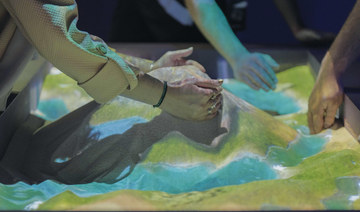RIYADH: He was a pioneering Saudi contemporary artist who exhibited abroad in exhibitions and biennales, but whose name was rarely heard at home.
Now, four years after he died alone and surrounded by his beloved works of art, Fahad Al-Hajailan is at last getting the recognition he deserves.
Mono Gallery, in collaboration with Naila Art Gallery, has revived his work with a “Al-Hajailan in the Mirror” exhibition commemorating the artist’s lost legacy.

Visitors examining the untitled work of late Saudi fine artist Fahad Al-Hajailan at Mono Gallery's 'Al-Hajailan in the Mirror' exhibition, in collaboration with Naila Art Gallery. (Photo by Mohammad Fattal)
Al-Hajailan, who died in 2018, was a founding member of the Riyadh Fine Art Group, a member of its advisory committee, and a pioneer in Saudi contemporary art.
He exhibited globally in shows and biennales in the US, China, the UK, Tunisia, France and Germany, but was all but unknown in the Kingdom, failing to gain the attention directed at headlining contemporary artists, such as Ahmed Mater, and Ayman Yossri.
With culture and creativity in the spotlight as part of Saudi Arabia’s Vision 2030 reforms, Mono Gallery decided to revive one of the country’s “lost treasures.”

Visitors examining the untitled work of late Saudi fine artist Fahad Al-Hajailan at Mono Gallery's 'Al-Hajailan in the Mirror' exhibition, in collaboration with Naila Art Gallery. (Photo by Mohammad Fattal)
Momen Al-Muslimani, the gallery’s founder, told Arab News that Al-Hajailan “was kept almost in the shade. No one knew how powerful he was at the time, 10 years ago.
“If someone is appreciative of an artist, first of all, they would buy his art at a general price, never trying to squeeze him or take advantage. There are a lot of art-lovers who are passionate collectors in the Kingdom. They should have run toward him 10 years ago, creating books, literature, (doing) interviews.”
FASTFACT
Four years after his death, galleries honor Fahad Al- Hajailan’s legacy.
According to Al-Muslimani, who was a close friend of Al-Hajailan, the artist never received the recognition he deserved.
Al-Hajailan spent most of his days in his studio, “painting away his emotions,” according to Al-Muslimani, who suggests the artist’s abstract style and poetic use of color reflect the mystery, sadness and sense of loneliness in his own life.

Visitors examining the untitled work of late Saudi fine artist Fahad Al-Hajailan at Mono Gallery's 'Al-Hajailan in the Mirror' exhibition, in collaboration with Naila Art Gallery. (Photo by Mohammad Fattal)
In 2018, Al-Hajailan died of a heart attack at age 61, in the middle of the night, alone and surrounded by his unappreciated works.
“Artists need someone else to feel on their behalf, to speak on their behalf, to express who they are on their behalf, because they forget themselves. They are completely inside the piece of artwork they’re creating,” Al-Muslimani said.
Instead of pursuing a degree in fine arts, which he could not afford at the time, Al-Hajailan spent much of his career as an art teacher, as well as curating cartoon graphics for Al-Jazeera and Al-Riyadh newspapers.

Visitors examining the untitled work of late Saudi fine artist Fahad Al-Hajailan at Mono Gallery's 'Al-Hajailan in the Mirror' exhibition, in collaboration with Naila Art Gallery. (Photo by Mohammad Fattal)
Only after discovering works by Leonardo da Vinci and Michelangelo did he realize that art did not have to be taught.
The true artist is never satisfied with his work, the gallery owner said, and this was the case with Al-Hajailan, who battled fatigue and hunger in a bid to create the ideal piece that would do his work justice.
“I’ve made this artwork, but I can do better. I can find more secrets in me,” Al-Hajailan would often say.
“The artist is most probably the only human on earth who does not have the choice to be an artist or not. He grew up having a pencil and a pen in his hand. He needs to draw; if he doesn’t draw, if he doesn’t paint, he would feel sick. And this is Fahad Al-Hajailan,” Al-Muslimani said.
Since his death, Al-Hajailan has been exhibited at the inaugural Diriyah Biennale and commemorated in Misk Art Institute’s Art Library book series.
Mono Gallery is presenting a timeline of his work, ranging from early pencil sketches in 1986 to the acrylic paintings of 2015.
“In Saudi contemporary art, we have a couple of pioneers — we can count them on by hand. One of them is Fahad Al-Hajailan. He is probably in the top three who people would never debate about. Everybody would speak with passion and love toward his art, his creativity. He is one of those treasures in the country.”
The exhibition runs until Nov. 28.














